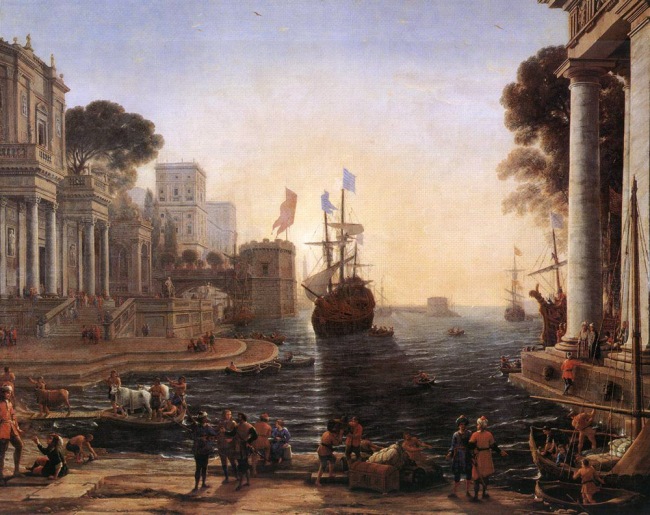My favorite work of art from the Baroque era is a landscape portrait by Claude Gellee, or Claude of Lorraine, also known as Claude Lorrain. Born in 1600 Claude grew up poor in the town of Champagne, province of Lorraine in France. Orphaned early on in life, Claude moved to Germany and then to Italy, he apprenticed first with his older brother Jean who was a woodcarver and then with painters, Godfrey Waals and Augustin Tassi. Claude’s career and independence as an artist didn’t start to really develop until he moved to Rome in 1627. By 1637, a decade later, Claude was considered a celebrity in his own right. The piece that I really like is his oil on canvas, Ulysses Returns Chryseis to her Father, painted in 1648. It is believed Claude resided in Rome until his death in 1682, at the age of 82. Thus this painting would have been painted in Rome, however it now currently resides in the Musee de Louve in Paris, France. This fact actually makes me quite disappointed, I visited Paris, France in the spring of 2000 and planned a day to go to the Louve, however when I arrived the museum workers were on strike and I couldn’t get in. It would have been great to see this painting up close.
Ulysses Returns Chryseis to her Father (1648)
In my opinion the painting is a beautiful evaluation of a port city, although it looks much like that in which Claude Lorrain may have seen while living in Italy, it should be a port city on the island of Chrȳsē near Troy, where Chryseis is from. This bustling seaport has beautifully tall white marble buildings, that gleam in the day’s sun, while presenting a stark contrast to the deep dark water in the harbor. You know the water must be deep in order to fit such big ships so close into shore, and thus the deep water darkens the center of the painting focusing your gaze right down the middle of the picture to where a large ship casts a foreboding shadow. The ship, itself just a small portion of the image, takes command as being an important element, it is also enlightened by the shining of the sun behind it. The golden rays that streak across the pale blue sky that Claude painted escape to all corners of the painting, highlighting the points of which need to be seen. This color and playing with light and shadow is what Claude Lorrain was famous for, he studied the natural world for many years, sun-up to sun-down, just trying to learn and understand how light plays and changes throughout the day. The landscapes of his art were his strong suit, and justly so, however it is known that in many of his painting the people were actually drawn by other artists because he just wasn’t any good at them.
It is likely no mere coincidence that Claude Lorrain came to be known as “The Prince of Landscape Painters”, being around in the Baroque era was to be surrounded by an emerging culture in scientific and natural discovery. We learned in the Baroque note taking assignment that the microscope was invented and bacteria were found during this era. There was also a great quest for knowledge for the new and exciting things being brought back to Europe from the New World, Africa and the Far East. Which included many flora and fauna that confronted the traditional intelligence on natural history, at least as it was seen in Europe and by the Catholic Church. The Baroque culture became a crossroads, encompassing the arts and the idea of Natural Philosophy that is said to have paved the way for the Scientific Revolution.
“Ulysses Returns Chryseis to her Father.” Art Renewal Center. n.p., n.d, Web 22 Jun 2014. http://www.artrenewal.org/pages/artwork.php?artworkid=5048&size=large
“Claude Lorrain”. Art Renewal Center. n.p, n.d., Web 22 Jun 2014. http://www.artrenewal.org/pages/artist.php?artistid=820
Gal, O. and R. Chen-Morris. Science in the Age of Baroque. Springer, 2013, Web 23 Jun 2014. http://books.google.com/books?id=ujDxezMEMgkC&printsec=frontcover#v=onepage&q&f=false


I enjoyed your blog, especially how you gave a history of the artist first, then your analysis of the painting.
This is a very detailed work. I can see why Claude was considered a master of landscapes. You can really feel that it is the end of the day, the bustle and activity of the dock and the anticipation of the ship landing. The linear perspective and composition of this piece is amazing.
I can see how this is related to the scientific portion of the age. Natural discovery and landscapes hadn’t really been done in abundance before the Baroque era and with the focus on realism and composition landscapes really came into prominence. Another great landscape piece is Landscape with St. John by Poussin http://smarthistory.khanacademy.org/poussin.html
The look of this blog overall was clean and symbol and well organized. The content was very good as well but i don’t fully understand the connection to scientific knowledge but I feel it would be closer to the rise of the merchant class. I think the landscape shows the large and exploding dock full of merchants in a large and prosperous city scape. I very much like this painting. I love how the darkness of the boat to draw your eye right to it but the darkness of the boat doesn’t make the painting itself dark. By the way I walked all through the Louve and seemed to miss it and i look forward to seeing it if I ever pass through again.